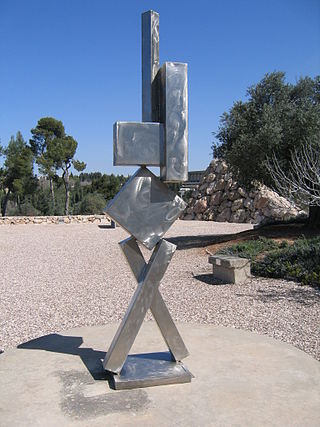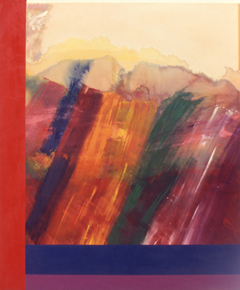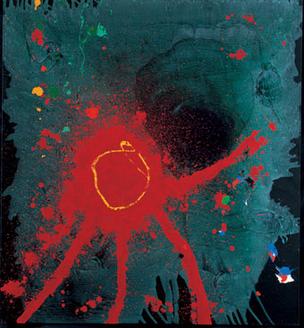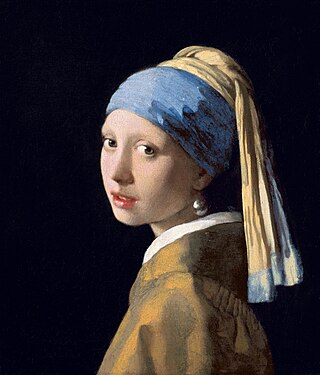Related Research Articles

Abstract expressionism in the United States emerged as a distinct art movement in the immediate aftermath of World War II and gained mainstream acceptance in the 1950s, a shift from the American social realism of the 1930s influenced by the Great Depression and Mexican muralists. The term was first applied to American art in 1946 by the art critic Robert Coates. Key figures in the New York School, which was the epicenter of this movement, included such artists as Arshile Gorky, Jackson Pollock, Franz Kline, Mark Rothko, Norman Lewis, Willem de Kooning, Adolph Gottlieb, Clyfford Still, Robert Motherwell and Theodoros Stamos among others.

Abstract art uses visual language of shape, form, color and line to create a composition which may exist with a degree of independence from visual references in the world.

Monochromatic painting has played a significant role in modern and contemporary Western visual art, originating with the early 20th-century European avant-gardes. Artists have explored the non-representational potential of a single color, investigating shifts in value, diversity of texture, and formal nuances as a means of emotional expression, visual investigation into the inherent properties of painting, as well as a starting point for conceptual works. Ranging from geometric abstraction in a variety of mediums to non-representational gestural painting, monochromatic works continue to be an important influence in contemporary art.

Color field painting is a style of abstract painting that emerged in New York City during the 1940s and 1950s. It was inspired by European modernism and closely related to abstract expressionism, while many of its notable early proponents were among the pioneering abstract expressionists. Color field is characterized primarily by large fields of flat, solid color spread across or stained into the canvas creating areas of unbroken surface and a flat picture plane. The movement places less emphasis on gesture, brushstrokes and action in favor of an overall consistency of form and process. In color field painting "color is freed from objective context and becomes the subject in itself."

Orphism or Orphic Cubism, a term coined by the French poet Guillaume Apollinaire in 1912, was an offshoot of Cubism that focused on pure abstraction and bright colors, influenced by Fauvism, the theoretical writings of Paul Signac, Charles Henry and the dye chemist Michel Eugène Chevreul. This movement, perceived as key in the transition from Cubism to Abstract art, was pioneered by František Kupka, Robert Delaunay and Sonia Delaunay, who relaunched the use of color during the monochromatic phase of Cubism. The meaning of the term Orphism was elusive when it first appeared and remains to some extent vague.
The Washington Color School, also known as the Washington, D.C., Color School, was an art movement starting during the 1950s–1970s in Washington, D.C., in the United States, built of abstract expressionist artists. The movement emerged during a time when society, the arts, and people were changing quickly. The founders of this movement are Morris Louis and Kenneth Noland, however four more artists were part of the initial art exhibition in 1965.

Robert Natkin was an American abstract painter whose work is associated with abstract expressionism, color field painting, and Lyrical Abstraction.

Ronnie Landfield is an American abstract painter. During his early career from the mid-1960s through the 1970s his paintings were associated with Lyrical Abstraction, and he was represented by the David Whitney Gallery and the André Emmerich Gallery.

Lyrical abstraction is either of two related but distinct trends in Post-war Modernist painting:
The Park Place Gallery was a contemporary cooperative art gallery, in operation from 1963 to 1967, and was located in New York City. The Park Place Gallery was a notable as a post-World War II gallery for both its location and that it supported a group of artists working with geometric abstraction and space.
Lucy Rowland Lippard is an American writer, art critic, activist, and curator. Lippard was among the first writers to argue for the "dematerialization" at work in conceptual art and was an early champion of feminist art. She is the author of 21 books on contemporary art and has received numerous awards and accolades from literary critics and art associations.
Dan Christensen, was an American abstract painter He is best known for paintings that relate to Lyrical Abstraction, Color field painting, and Abstract expressionism.

The history of Western painting represents a continuous, though disrupted, tradition from antiquity until the present time. Until the mid-19th century it was primarily concerned with representational and Classical modes of production, after which time more modern, abstract and conceptual forms gained favor.
Edward Avedisian was an American abstract painter who came into prominence during the 1960s. His work was initially associated with Color field painting and in the late 1960s with Lyrical Abstraction.

20th-century Western painting begins with the heritage of late-19th-century painters Vincent van Gogh, Paul Cézanne, Paul Gauguin, Georges Seurat, Henri de Toulouse-Lautrec, and others who were essential for the development of modern art. At the beginning of the 20th century, Henri Matisse and several other young artists including the pre-cubist Georges Braque, André Derain, Raoul Dufy and Maurice de Vlaminck, revolutionized the Paris art world with "wild", multi-colored, expressive landscapes and figure paintings that the critics called Fauvism. Matisse's second version of The Dance signified a key point in his career and in the development of modern painting. It reflected Matisse's incipient fascination with primitive art: the intense warm color of the figures against the cool blue-green background and the rhythmical succession of the dancing nudes convey the feelings of emotional liberation and hedonism.
James Welling is an American artist, photographer and educator living in New York City. He attended Carnegie-Mellon University where he studied drawing with Gandy Brodie and at the University of Pittsburgh where he took modern dance classes. Welling transferred to the California Institute of the Arts in Valencia, California in 1971 and received a B.F.A. and an M.F.A. in the School of Art. At Cal Arts, he studied with John Baldessari, Wolfgang Stoerchle and Jack Goldstein.
Neil Williams, was an American painter and educator. Williams was an abstract painter primarily known for his pioneering work with shaped canvases in the early 1960s. His paintings of the 1960s, 1970s and 1980s are associated with geometric abstraction, hard-edge painting, color field, and lyrical abstraction, although he did not readily subscribe to any category for his work. He taught fine arts at the School of Visual Arts, from the late 1970s until the early 1980s.
Carroll Dunham is an American painter. Working since the late 1970s, Dunham's career reached critical renown in the 1980s when he first exhibited with Baskerville + Watson, a decade during which many artists returned to painting. He is known for his conceptual approach to painting and drawing and his interest in exploring the relationship between abstraction and figuration.

Victor George Kord is an American painter and educator. He currently maintains a studio and exhibits in New York City. He previously served as art department chair for several major universities, and remains professor emeritus of painting at Cornell University Department of Art.
Harvey Sherman Harris was an American artist and art professor. His art combined elements of Realism (arts) and Abstract Expressionism.
References
- ↑ "David R. Prentice (American, 1943)". Artnet. Retrieved 2008-03-30.
- ↑ Landfield, Ronnie (1995). "3. In the Late Sixties". Lyrical Abstraction. abstract-art.com. Retrieved 2008-03-30.